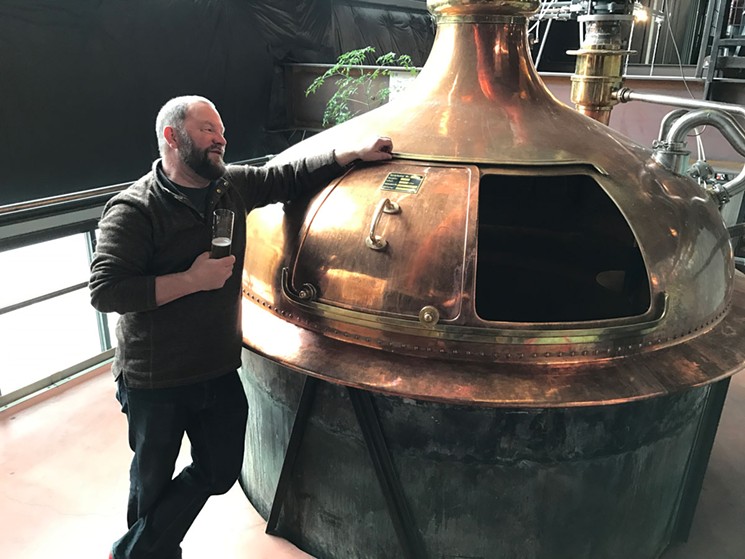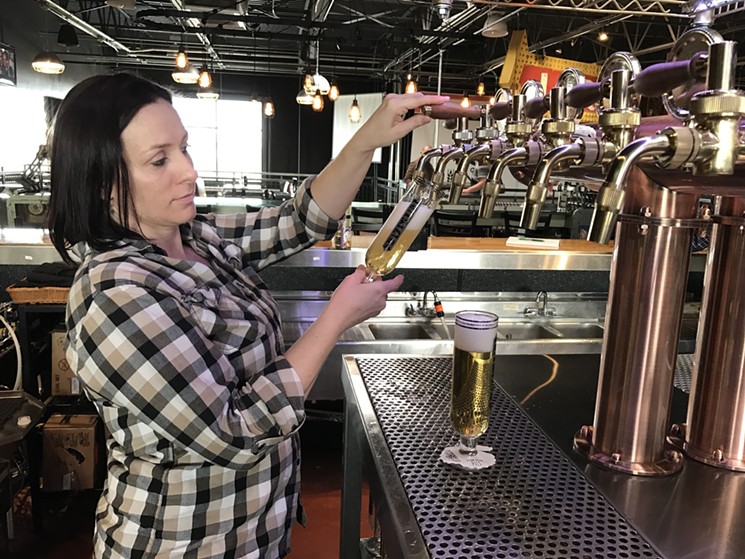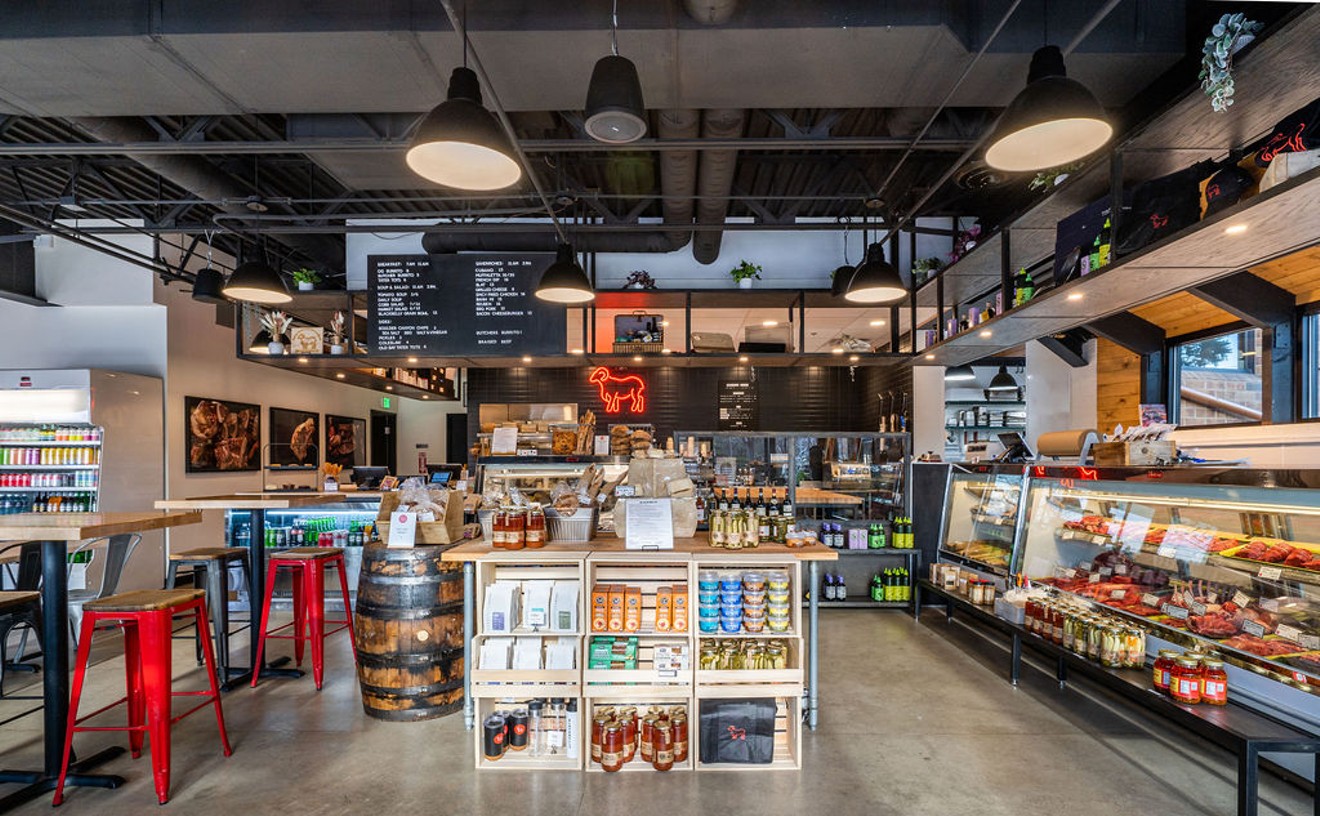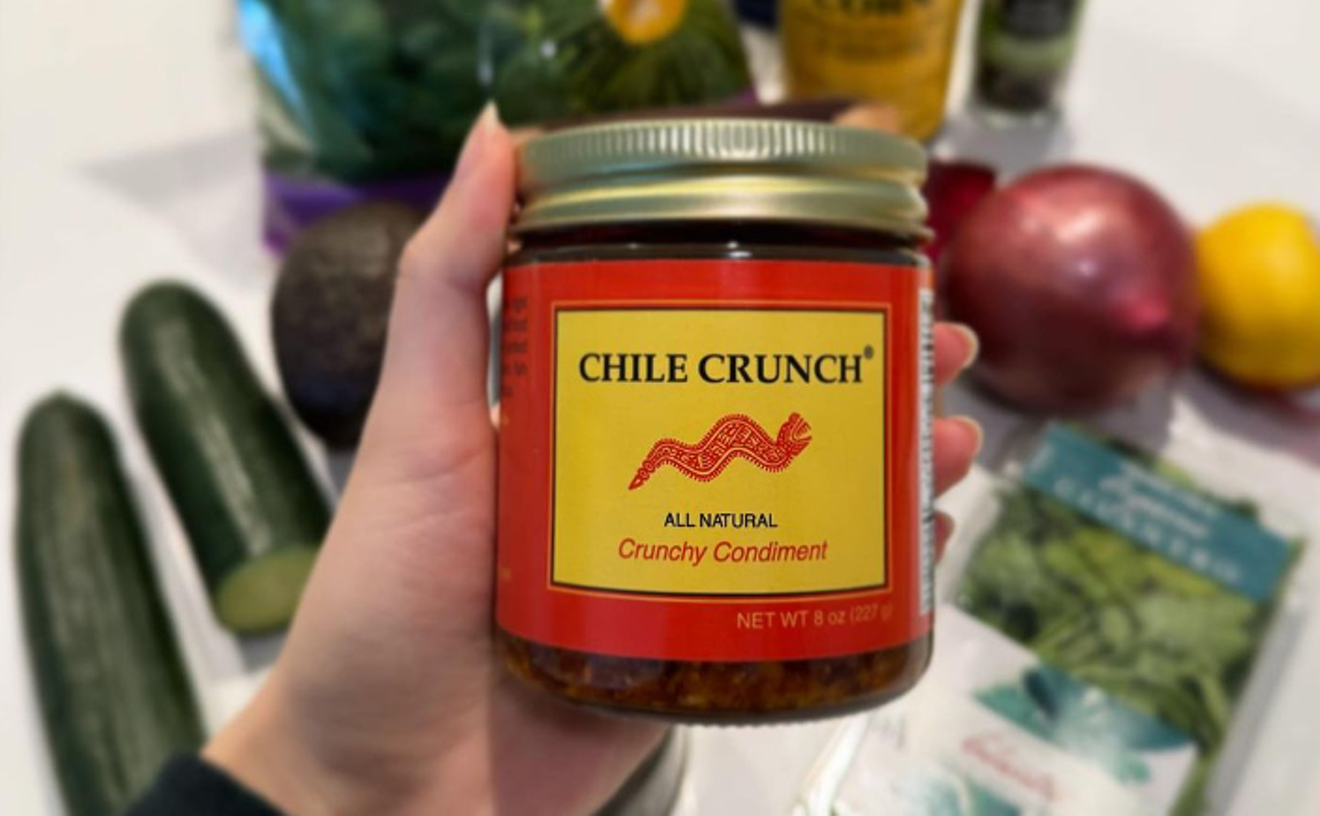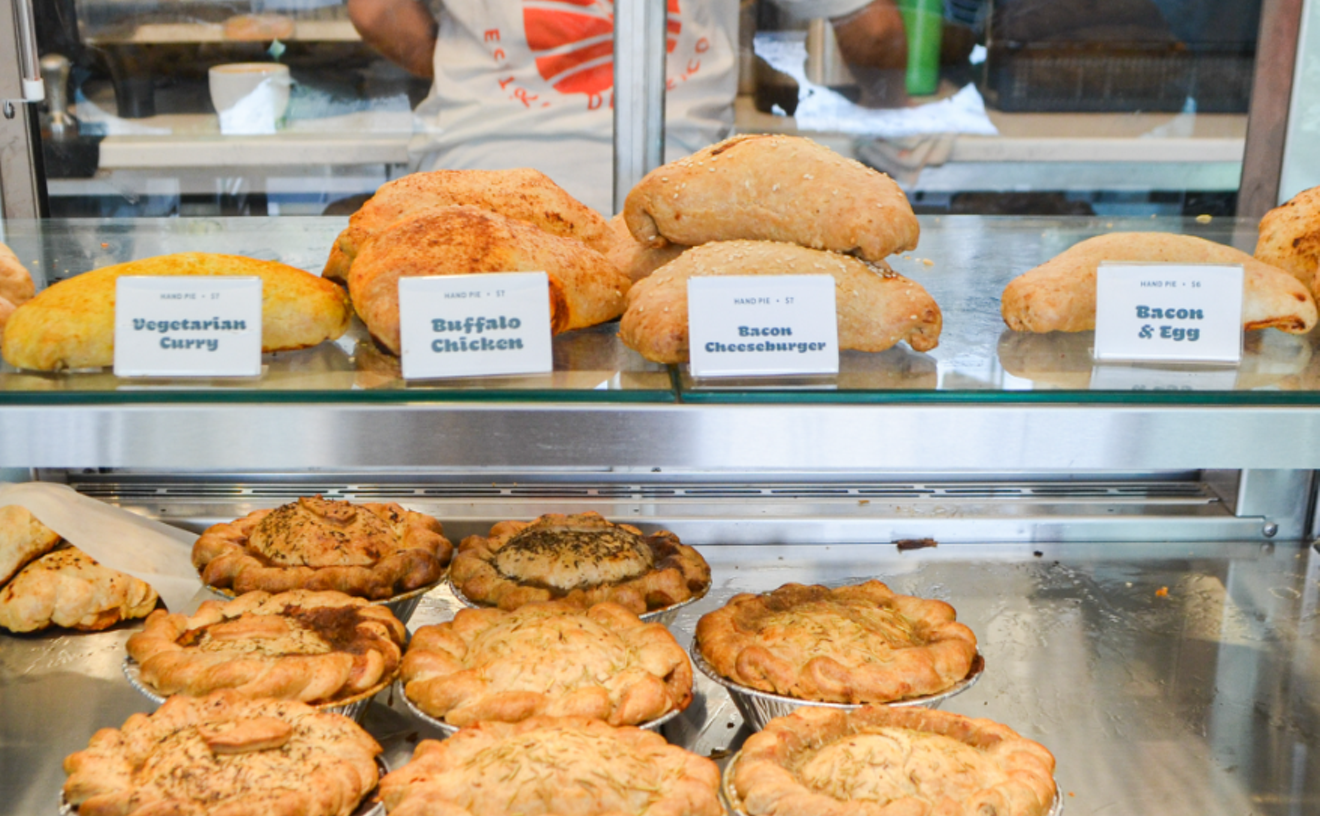Valliere, the sales director for Bierstadt Lagerhaus, starts running down the details of the pilsner, helles and dunkel — and the glassware that the brewery has picked to be used for each one. The Slow-Pour Pils, in particular, stands out; it’s Bierstadt’s biggest seller by the glass, both inside and out of the brewery, and it is only permitted to be poured into a tall, elegant, 10.14-ounce glass made for the brewery by Sahm, a German company.
This is work, but it’s not hard work, since Valliere, Kentucky Inn manager Becky Reitz and bartender Jackie Byrnes are tasting each beer to decide which would work best on tap at the bar. “We’re living in Denver, the beer capital of the world. You need to have an open spectrum of beers,” Byrnes says. The new owners of the Kentucky Inn, a group that includes longtime Denver restaurateur Rich Salturelli, have spruced up the Washington Park mainstay over the past nine months, adding flat-screen TVs and twenty tap handles, many of them craft beer. That means the mega-brewers that once held sway at the former dive bar have taken a back seat to IPAs, saisons and locally made lagers.
“Bud and Coors have had 75 years to dumb-down beer drinkers,” Valliere tells Reitz and Byrnes. “So we’re pushing the importance of respecting beer — its aesthetics, its aroma. Beer is just like food, so ordering a beer should be like going to dinner at a restaurant. The first thing you notice when your food comes out is what it looks like, and you pre-judge it on that, before you even taste it.
“We want beer to be respected the same way,” he adds.
The key to that is presentation: Since Bierstadt opened at 2875 Blake Street one year ago this month, Valliere and owners Bill Eye, Ashleigh Carter and Chris Rippe have insisted that every bar or restaurant that wants to serve their beer — and there are plenty of them — do it only in a Bierstadt glass.“Bud and Coors have had 75 years to dumb-down beer drinkers, so we’re pushing the importance of respecting beer — its aesthetics, its aroma."
tweet this
Bierstadt is the only craft brewery in Denver, and in Colorado, that requires outside accounts to use its specific glassware. It’s a risky, hard-line approach that has annoyed some people and lost a few sales, but also engendered significant respect. And it seems to be working.
“I can make an ocean of beer and sell it all over town. But I get so tired of walking into a bar and finding my beer to be unrecognizable, displayed so poorly in a dirty shaker pint glass,” says Eye, who has been brewing highly decorated beers in Colorado for more than twenty years, notably at Dry Dock Brewing, where he helped win the prestigious Small Brewing Company Brewer of the Year award in 2009. “There is nothing about the pint glass that enhances the experience for anyone,” he continues. “Sure, it’s cheap and durable, but here’s what a bar is really saying if they use one: ‘I’m lazy and I want something that’s easy for me. I don’t care about what’s good for the customer.’”
Bierstadt also prefers that a potential account send some of its staffers to the Rackhouse to learn about the beers, the glasses and how to pour them — as the Kentucky Inn employees are doing today. “At the risk of being controversial, the bars make five times more than we do on each keg that we sell to them. So we want partners, not just customers,” Eye says. “We will sink or swim with this.”
So far, Bierstadt has convinced forty partners to serve its beer on permanent tap handles and to use its glasses. Most of these accounts bought the pilsner and its prescribed glasses; the rest bought the helles.
“Me and Drew Watson from Hops & Pie went back and forth for months,” remembers Valliere, who hosts American Craft Beer Radio, a show on AM 1340 and FM 104.7 that focuses on craft beer. “He would text me and ask, ‘When can we put the pils on?,’ and I would say, ‘When you take the glasses, Drew.’ He loved the beer, but they don’t have a lot of room, and he was worried about breaking them. Then, a few weeks later, I would text him and ask, ‘When are you going to put the pils on, Drew?,’ and he would say, ‘When I don’t have to use the fucking glass, Gary.’” Watson eventually took the glasses.
“Everyone thought we were crazy when we started,” Valliere adds. “Erik Peterson with Bull & Bush — he said, ‘You know, I don’t think anyone can pull this off. If you do, you will be a revolutionary.”
It takes three to five minutes for the bartender to prepare each glass of the unsurprisingly named Slow Pour Pilsner. She starts by grabbing the pilsner glass, which is tall, with a small stem. Then she fills it about two-thirds of the way with the crystal-clear beer. Once that settles, she pours more, slowly, this time letting some head build up. Finally, after another resting period of about a minute, the bartender returns and tops it off with a thick, foamy two-inch head that resembles soft-serve ice cream. The result is a masterpiece that goes down smoothly.
“An interesting thing happens when you pour it this way. It releases some of the carbonation and softens the beer; the bitterness goes away,” Carter says. “If you taste our pilsner poured this way compared to one that isn’t, I believe you can tell the difference. It changes the texture of the beer.”
Special taps with screens inside the faucets also help this process by aerating the beer as it is poured. The shape of the glass adds to the overall experience because it shows off the clarity of the beer, Carter adds. An etched number (called a nucleation point) at the bottom of the glass helps release some of the carbonation, which creates a lovely stream of bubbles that flow up toward the top of the glass.
Spend a few minutes with Carter or Eye and you’ll understand that they only do things one way. For instance, the pair brews just three year-round beers — pils, helles and dunkel — that are all lagers, as well as a handful of seasonals, including a maibock, a Vienna lager, a Baltic porter and Oktoberfest. And they brew them as closely as possible to fit the Reinheitsgebot, a set of sixteenth-century Bavarian beer-purity laws that require, among other things, that beers are brewed with nothing more than barley, hops and water. You won’t find any additives in Bierstadt beers, or modern twists or innovative recipes. Just tradition.
To equip their brewhouse, in 2014 Eye and Carter traveled to the Bavarian town of Ammerndorf to buy a thirty-barrel copper brewing system built in 1932. A pre-World War II relic, it didn’t exactly come with an instruction manual; Carter took plenty of pictures so they could rebuild it after shipping it to Denver.
They only have brew days three or four times a month, when Eye and Carter spend 25 to 30 hours straight at the brewery (they have a hammock for naps).
And you won’t find any little tasting glasses behind the bar for flights — something that is de rigueur at most breweries. There is only one way to order a Bierstadt beer at the Rackhouse, or anywhere else, and that’s a full pour in the correct glass. “Tasters are one of my least favorite things,” Eye explains. “Why would you want to present your beer that way?” Instead, if customers want to try a small amount of the beer before they buy a full pour, they can sample it in the proper glassware.“This is a beer-drinker’s glass, a working person’s glass. It’s utilitarian and easy to get your face into."
tweet this
There are three main styles of Bierstadt glasses. The first is the pilsner glass. “It’s elegant,” Eye says. “And the narrow glass helps with the aroma.”
The second is the chunky half-liter (about seventeen ounces) helles mug, which comes with a handle that makes hearty toasting easy. “This is a beer-drinker’s glass, a working person’s glass. It’s utilitarian and easy to get your face into,” Eye says. It’s also the traditional glass used for helles in Germany.
The third one, used for the dunkel, is also tall, but wider than the pilsner glass and comes in at a half liter. “I picked it because it was beautiful,” Eye says. “I don’t want to imbue these glasses with any magical properties. They are just beautiful.”
Eye and Carter got the idea to insist on their own glassware about a year before Bierstadt opened, while they were holding a “planning session” at Ernie’s Pizza in northwest Denver and drinking Peronis.
The Peronis, an Italian lager, were delivered in Peroni glasses, and they looked good — both to Eye and Carter, and to the other customers at Ernie’s. “After we got our beers, I saw about six more Peronis go out,” Eye says. “It’s a smart way to sell beer. In Germany, when you order a beer at a bar, you get the brewery’s specific glass. In Belgium it’s the same. People care about their beer, and we decided that we want the people who buy beer from us to care about it, too. We just think it goes better with the glass. The Europeans have it right.”
The goal then became not just to make top-notch lagers, but to change beer culture in Colorado by focusing on presentation and how that can affect the beer.
“Bill won’t tell you this, but he is one of the few people who has the product and credibility to do that,” says Rippe, who went into business with Eye and Carter in 2014 after closing the first Rackhouse, at 208 South Kalamath Street. “When you do things differently, it sometimes takes some convincing. But if the bar or restaurant is really about beer, it’s not hard to convince them to do something that will benefit the beer and the culture and their customers. We also frame it as something that is more profitable. If they buy the glass, they will sell more beer. Sometimes they need us to prove it.”
And prove it they have. Not one of his accounts is selling less than one keg per week — which Valliere credits to the beer, the glasses and the training, which typically takes place at 11:30 a.m. on Tuesdays. “I sit down and explain to them what we’re doing. I start with the pils,” he says.
Once the new account takes the beer, Valliere, Eye and Carter check in to make sure the glassware is being used. “One account was serving it in a goblet, so I had to ask them about that,” Valliere says. “If they keep doing it, we will pull the beer. For the most part, everyone who has done it has done it well.” (So far, Bierstadt has only made one exception to its glassware rule, and that was for the Alamo Drafthouse, which serves beer in the dark during movie screenings, when the glasses could easily be broken.)
To make things easier for a new account, Bierstadt reduces the price of the first keg of beer so that the bar or restaurant can more easily afford to buy the glasses. “It costs us $4.70 for each glass; it’s not cheap,” Eye explains. “But we offer them to our accounts for $3. Since we sell each keg for $145, it’s not really a leap to spend another $18 or so for six glasses, but we reduce the price of the first keg by $18.”
Price isn’t the big obstacle, anyway: Bar owners complain that the glasses don’t stack well with other glasses; don’t fit easily into racks, shelves or washing machines; and have the potential to break easily or get stolen, forcing the business to buy more. Hops & Pie broke one before it even tapped the beer. Reitz says she has no idea where the Kentucky Inn would store the glasses, as there isn’t much room behind the bar.“Even dive bars usually have two different glasses for wine — one for red and one for white. So why not beer?"
tweet this
Eye has no sympathy. “Bars have specific glasses for Moscow Mules and martinis and margaritas,” he says. “Even dive bars usually have two different glasses for wine — one for red and one for white. So why not beer? For some of them, it’s logistically hard to have fifteen different styles of glasses, I know. But even the tiniest places in Belgium do it.
“Are you a beer bar or not? That is the question.”
But to get the right answer, it helps that Bierstadt makes only two of its beers available for sale outside the brewery: the pils and the helles. For other breweries, the same strategy might not work. “Epic Brewing has eighteen beers on tap, so I don’t know how they’d manage it,” Eye acknowledges.
And so far, no other Colorado brewery has insisted that its beer be sold in its own glassware. “There is a definitely a wait-and-see on this from other breweries to see if it will work,” Eye says. “I heard from someone that the bigger breweries are looking hard at this, but none are doing it.”
The Kentucky Inn went with the helles, putting it on a permanent handle there; it was soon one of the bar’s top sellers. That’s partly because people love the way the big mugs look when they’re handed out over the bar; people have tried to buy the mugs and also to steal them. “It’s the only beer we have that is served that way,” Byrnes says, “and we’ve only broken one so far.”
The Kentucky Inn is currently closed for a kitchen remodel, but when it reopens in early September, the helles will be back on tap, along with a seasonal Oktoberfest from Bierstadt. “We love those guys,” Byrnes says. “They make a great product, and I send people over to the brewery all the time.”
Shortly after the Kentucky Inn began selling the helles, Eye and Valliere showed up to see how things were working — and they wound up buying beers for staffers and customers alike. “Nobody else does that,” Byrnes concludes. “Nobody else shows up and buys beer for other people.”



